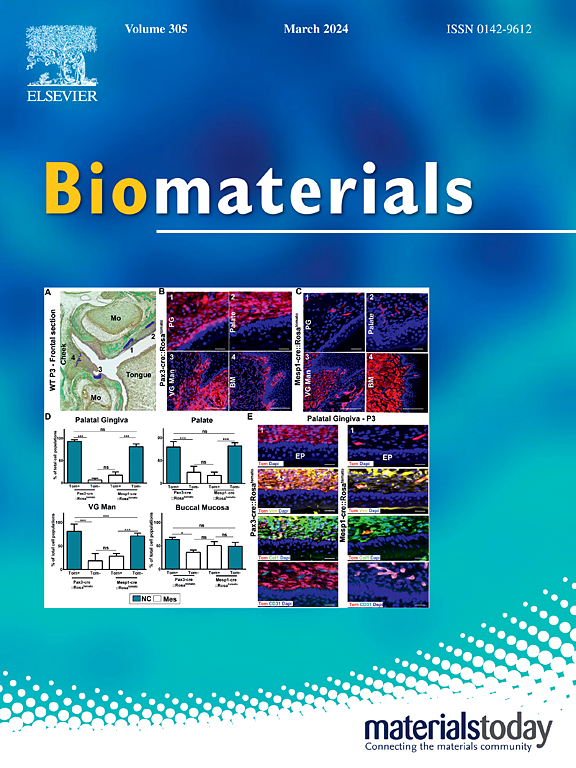MXene-loaded multifunctional nanoparticles with on-demand controlled antimicrobial and antioxidant capacity for multi-modal treating bacterial prostatitis
IF 12.8
1区 医学
Q1 ENGINEERING, BIOMEDICAL
引用次数: 0
Abstract
Bacterial prostatitis represents a specific form of prostatitis, primarily resulting from bacterial infection and significantly impairing the life quality of patients. In this paper, we respond to the inability of conventional drugs to simultaneously address both bacterial infection and oxidative stress in the treatment of prostatitis by designing a multifunctional nanoparticle, called QM (Cu) NPs, with dual functionality. QM (Cu) NPs have the capacity to generate reactive oxygen radicals to eradicate bacteria under the influence of laser irradiation. Additionally, they are capable of rapidly scavenging the surplus free radicals, thereby restoring the intracellular redox homeostasis in the absence of laser illumination. A comprehensive characterization of QM (Cu) NPs was conducted, followed by an in-depth analysis of their effects on cells. The therapeutic efficacy of QM (Cu) NPs in multimodal treating bacterial prostatitis was then demonstrated. Furthermore, the outcomes of transcriptomic and molecular biology experiments indicated that QM (Cu) NPs markedly regulate the NF-κB p65 and Nrf2-Keap1 signaling pathways, thereby influencing inflammatory and oxidative stress processes. In conclusion, QM (Cu) NPs simultaneously addressed the dual challenges of antibacterial and antioxidant properties, thereby underscoring their potential clinical applications in the treatment of bacterial prostatitis.

负载mxene的多功能纳米颗粒具有按需控制的抗菌和抗氧化能力,用于多模式治疗细菌性前列腺炎
细菌性前列腺炎是前列腺炎的一种特殊形式,主要由细菌感染引起,严重影响患者的生活质量。在本文中,我们通过设计一种具有双重功能的多功能纳米颗粒,称为QM (Cu) NPs,来应对传统药物在前列腺炎治疗中无法同时解决细菌感染和氧化应激的问题。在激光照射作用下,QM (Cu) NPs具有产生活性氧自由基以消灭细菌的能力。此外,它们能够快速清除多余的自由基,从而在没有激光照射的情况下恢复细胞内氧化还原稳态。对QM (Cu) NPs进行了全面的表征,然后深入分析了它们对细胞的影响。证实了QM (Cu) NPs在多模式治疗细菌性前列腺炎中的疗效。此外,转录组学和分子生物学实验结果表明,QM (Cu) NPs可显著调节NF-κB p65和Nrf2-Keap1信号通路,从而影响炎症和氧化应激过程。综上所述,QM (Cu) NPs同时解决了抗菌和抗氧化特性的双重挑战,从而强调了其在治疗细菌性前列腺炎方面的潜在临床应用。
本文章由计算机程序翻译,如有差异,请以英文原文为准。
求助全文
约1分钟内获得全文
求助全文
来源期刊

Biomaterials
工程技术-材料科学:生物材料
CiteScore
26.00
自引率
2.90%
发文量
565
审稿时长
46 days
期刊介绍:
Biomaterials is an international journal covering the science and clinical application of biomaterials. A biomaterial is now defined as a substance that has been engineered to take a form which, alone or as part of a complex system, is used to direct, by control of interactions with components of living systems, the course of any therapeutic or diagnostic procedure. It is the aim of the journal to provide a peer-reviewed forum for the publication of original papers and authoritative review and opinion papers dealing with the most important issues facing the use of biomaterials in clinical practice. The scope of the journal covers the wide range of physical, biological and chemical sciences that underpin the design of biomaterials and the clinical disciplines in which they are used. These sciences include polymer synthesis and characterization, drug and gene vector design, the biology of the host response, immunology and toxicology and self assembly at the nanoscale. Clinical applications include the therapies of medical technology and regenerative medicine in all clinical disciplines, and diagnostic systems that reply on innovative contrast and sensing agents. The journal is relevant to areas such as cancer diagnosis and therapy, implantable devices, drug delivery systems, gene vectors, bionanotechnology and tissue engineering.
 求助内容:
求助内容: 应助结果提醒方式:
应助结果提醒方式:


